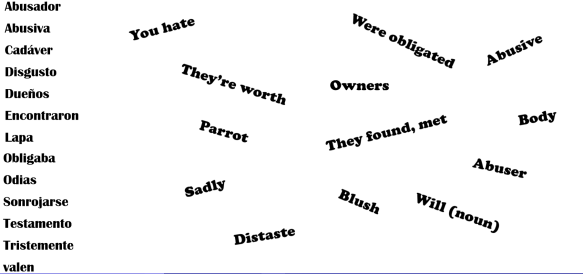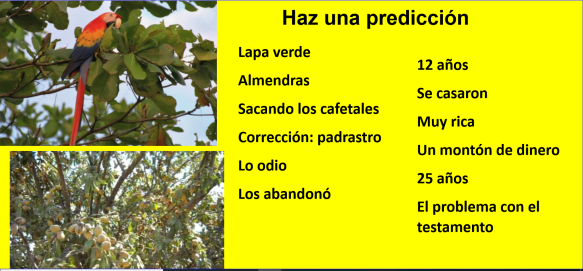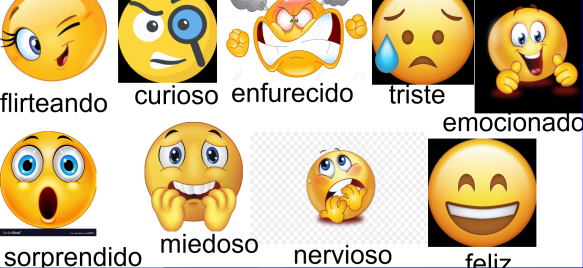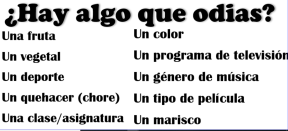As I mentioned in my last post, this is our first year working with Noche de Oro by Kristy Placido, so I’m on a learning curve with my students. My awesome colleague, Megan Matthews, and I have discovered that this book is a more challenging read for many of our Spanish III students. We have worked hard to come up with a number of reading support activities that will help our weaker readers and still engage the stronger ones.
Chapter 3
- We took several sentences from the chapter to work with before reading. We asked students to try to determine the meaning of the underlined sections based on context. It was a struggle at first, and so we did what they could the first time through. The second time, I added English suggestions to choose from.
- Carolina se dio la vuelta y se encontró cara a cara con un hombre joven y guapo.
- Era un buen indicio de que él estaba tomando su posición en serio.
- Ella dirigió al chofer a una de las casas que no estaba ocupada.
- Creo que no pudo resistir mi increíble personalidad.
- Ella no conocía a él.
- No sabía si le gustaba la idea de confiar tanto en él.
- Jacques la saludó con dos besos.
- El chofer dejó las maletas hace una hora.
- Los ojos le brillaban con la sonrisa.
- Me avisó que él iba a vivir con su hijastro.
- Carolina se preguntaba cuántos años tendría este hijo…..
- We spent some time talking about judging people by their appearance. I googled some images to show the same people from different perspectives and we had some fun, useful conversation.
- We also used the Venn diagram from the TG.
- We played Kahoot for chapter 3 only.
- If you use gimkit, here is one I made for Chapters 1- 3.
Chapter 4
- We listened to chapter 4. I strongly encourage the purchase of the audio CD if your funding allows for it. It is a nice change and can be used with or without the book, depending on your purpose.
- We prepared a list of statements that we used for two different activities. First, in small groups of 2-3 students, the students received all of the statements and the following categories: Martin, Jacques, Carolina, las cajas, la casa. The task was to match the statement to the category. For the second activity, only the teacher has the list of statements. The students had the category cards. I would read a statement and they grabbed or touched the appropriate category. Each group kept their own score. For my class that was still encountering difficulty, I turned this into at third activity with 4 teams (this is my smallest class). Each team sent a member to the front of the class to sit with a whiteboard and marker. I read the statement and they wrote the appropriate category.
- Le gustaba mucho la mirada misteriosa
- lo que dejó el chofer
- no está muy limpia
- Era una sorpresa para Carolina
- hablaba de una manera informal
- tenía 20 anos
- tenía cabello desordenado
- dirigió el chofer hacia una de las casas que no estaba ocupada.
- eran iguales
- tenía una sonrisa genuina
- Tenían una palabra extraña estampada en un lado.
- Estaba sonrojándose un poco al ver a Jacques.
- Tenía una mirada misteriosa y peligrosa
- Eran grandes y nuevas
- Era joven
- Iba a llamar al servicio de limpieza.
- tenía tres tatuajes
- Saludó a Carolina con dos besos.
- Hablaba de una manera informal.
- Donde puso el chofer las cajas.
- Oyó la discusión entre Jacques y Martín
- Caminó a la casa de Jacques y Martín
- Sentía una intensa curiosidad sobre las cajas
- Dijo que su madre era una tica tonta
- Tenía papeles, CD’s, una laptop, memorias y la palabra OROTEC
- Dijo que si quiere el dinero, tiene que cerrar la boca y trabajar.
- No quiere que Jacques la vea y esconde detrás de una caja.
- Está 15 minutos de la oficina de Carolina.
- Donde están las cajas
- Donde Jacques hizo las llamadas telefónicas
Carolina Jacques Martín Las cajas La casa 3. We used the star puzzle as well as the prueba in the TG.
Chapter 5
- To prepare to read Chapter 5, we developed these five “mini stations” to use. Students were working with a partner with this document: Chap 5 mini stations. About every 5 minutes, I called “time” for them to move to a different part of the document. I also spent 5 minutes with each of my desk pods (I have 5 pods of 4 – 6 desks each) to do the oral piece (station #1) with that group. On each pod of desks was a laptop so that they could watch the assigned video. The entire activity went very well and really prepared them for what they would encounter in chapter 5.
- As we read chapter 5, each student had a copy of this document: student copy for chapter listening. On the board, via a SMART presentation (which I can’t upload on wordpress) were projected questions and possible answers. They read, listened and selected answers as we read. Samples: In response to the question ¿Cómo era Gabriel? 1. Hay 3…
amable bruto moreno rubio
cómico joven misterioso alto
peligroso aburrido inteligente divertido In response to: 2. ¿Qué lo llamaron los estudiantes de Gabriel? a. Señor Ording b. Gabriel c. Profesor In response to: 3. ¿Que estudiaron los estudiantes que llevó Gabriel a la hacienda? a. El impacto de las actividades de los humanos en el medioambiente
b. El impacto de temblores en Costa Rica y la necesidad para reforestacion.
c. El impacto de las aves y iguanas en el medioambiente
3. We used the TG assessment pictures as practice and I added some matching statements to the 6 main characters.
4. We did a free write on Jacques/Martin. ¿Qué sabes sobre Jacques Mauvais?
¿Cómo es?
¿De dónde?
Descripción física
Descripción de su personalidad/carácter
Su familia
¿Dónde vive?
¿Qué quiere? ¿En qué tiene interés?
¿Qué sabes de Martín?
¿Cómo es?
¿De dónde?
Descripción física
Descripción de su personalidad/carácter
Su familia
¿Dónde vive?
¿Qué quiere? ¿En qué tiene interés?
Chapter 6
- We used the audio guide again with this chapter. Students used this document: ch 6 worksheet for audio guide with SMART to answer these questions (projected on a SMART presentation) Párrafos 1/2
1. ¿Qué pensaba Alex sobre Martín?
Párrafos 3/4
2. ¿Cómo estaba Martín cuando vio el microbús?
Párrafo 5
3. ¿A dónde fueron para comer?
4. ¿Quién era el mejor bailador/bailarín?
Párrafo 6
5. ¿A dónde quería ir Makenna?
6. ¿Cómo estaba Makenna después de bailar?
Párrafo 7
7. ¿Dónde decidieron sentarse?
8. ¿Quién pensaba en besar?
Párrafo 8
9. ¿A dónde tuvieron que ir Makenna y Martín?
10. ¿Cómo estaba Makenna?
Párrafo 9
11. ¿En qué pensó Makenna?
12. ¿Cómo fue Martín cuando su padrastro le gritó sobre el trabajo?
By this point of the book, two of my three sections did not need to be so “guided” during reading, but my third section, the group with the greatest range of abilities (from exceptionally weak to above Spanish III), really appreciated the additional support, as indicated by asking them to respond anonymously to the question “Did this help?” student response to working through chapter
2. We used the Reader’s Theater in the TG.
3. We did an “order the chapter” activity in groups of two (each group had sentence strips on cardstock to order). Additionally we read them aloud and I had random groups do some translating of the sentences. Chap 6 order the chapter
4. We played Kahoot for chapters 5/6.
Chapter 7
- We spent some time talking about “Odiar” using a detailed SMART presentation. Here are some samples from it:
2. We explored some of the vocabulary in the chapter
and we made some predictions based on these words: 
3. We played the marker game (Cynthia Hitz). I used the true/false statements from chapter 7 with an additional 15 that I wrote.
4. We used this Review through 7 twice. The first time, in small groups of 2 – 3, they sorted through all of the cards placing them in categories of their creation (I had 8 or 9 sets printed on cardstock and cut out). The second time, in teams of 4-5, we played the Reading Game. I read a statement, the team member wrote the answer, and if correct, drew a card. See the post for scoring information.
Chapter 8
- Chapter 8 is a short, fun read. I assigned each of my desk pods a sound effect to produce as we read. Sonido: make sounds
Moto: Vroom Vroom Vroom
Cataratas: Swooshhhhhhh
Martín: ¡Pura Vida!
Makenna: ¡Bésame! - If you have gimkit, here is a gimkit I created for chapters 5 – 8.
Chapter 9
- We used the suggested “emoticon” activity in the TG. I projected 9 emoticons, we practiced the pronunciation and generally had some fun with them. We then took 3 sentences from the chapter (this is prior to reading chapter) and determined meaning and pronunciation. I then passed out an “emoticon” card to everyone (yes, there were duplicates and triplicates). We practiced reading the sentences with our seat partners. Then, we got up inner/outer circle and I then said “Sentence 1”. They read the sentence based on the emoticon and their partner guessed which emoticon it was. They exchanged emoticon cards and the outer circle shifted one person to the right. This was a FUN activity.

- We played charades/pictionary with short sentences and vocabulary from chapter 9.
- We used the suggested assessment in the TG with some additional questions.
Chapter 10
- We used the TG powerpoint (with additional images) to talk about our fears. I also added many slides of dangerous bridges to our SMART presentation for this chapter (with appropriate scary, anxious music).
- As we read chapter 10, I used lighting and music to amplify the “drama”.
- We used the suggested post reading questions in groups of three.
When our break is over, we still have 3 chapters to read. I’m a bit apprehensive that the students will have forgotten some of what we have done, but we are determined to wrap the book up in the first week after break. We then will move on to Felipe Alou!
I’m really interested in what you may have created for this book by Kristy Placido. Also, if you use any of these activities, I’d love to know how they go for you. Finally, I conclude this post by saying I am NOT a native speaker. I’m sure there are errors which I will gratefully correct if pointed out!


